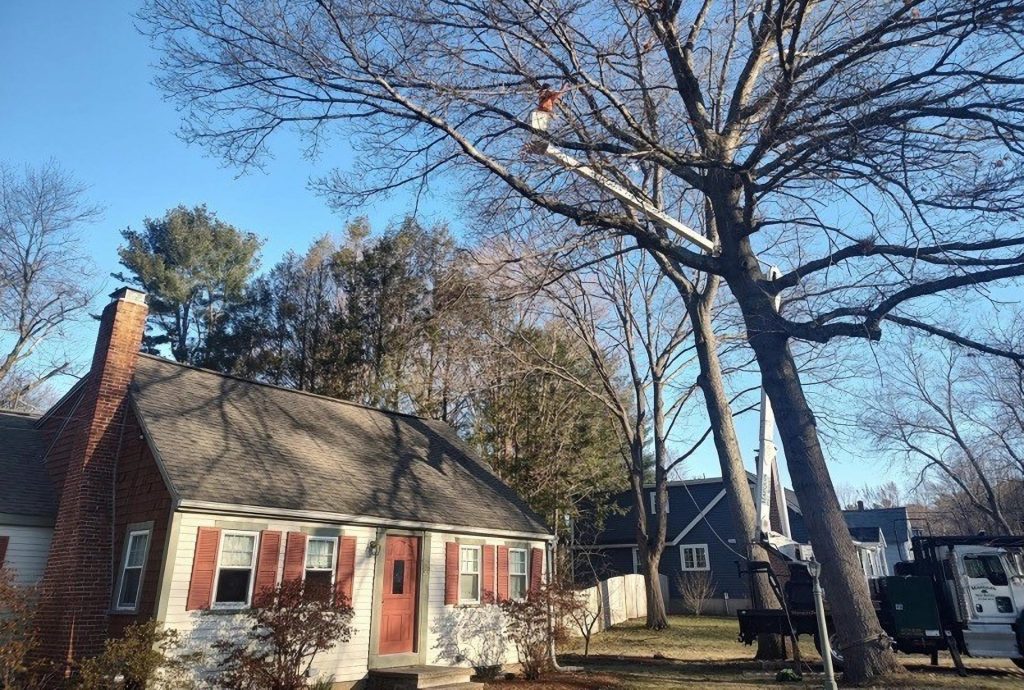Spring is an ideal time to care for your trees and ensure their health after winter. Start by checking for winter damage like broken branches or peeling bark. Grab your pruning tools and trim back dead or damaged limbs, but don’t go overboard—just 10-20% of the canopy. Apply a slow-release fertilizer evenly around the drip line to provide essential nutrients. Keep an eye on watering, ensuring deep moisture for those thirsty roots. Use natural pest control methods, such as neem oil, while promoting beneficial insects to sustain a balanced ecosystem.
Consider creating a spring tree care checklist to ensure you cover all essential tasks and help your trees stay healthy and thrive throughout the season.
The experienced arborists at Marquis Tree Service do an excellent job providing spring tree care tips that safeguard your tree’s health. Don’t hesitate to reach out!
Inspect for Winter Damage
Begin your spring tree care by inspecting your trees for winter-related damage. Pay special attention to mature trees, which are more prone to damaged or broken limbs requiring immediate care. Examine the branches, trunk, and roots closely for any signs of stress, fungal growth, or injury. Winter conditions like heavy snow, ice, and strong winds can cause significant stress to trees.
First, check for any broken or hanging branches. These can be dangerous and should be removed as soon as possible. Look for cracks in the tree trunk, which can weaken the structural integrity. Also, keep an eye out for any areas where the bark might be peeling or discolored. This could indicate fungal disease or damage that needs attention.
Next, move down to the tree roots. If you see any roots that are exposed or damaged, your tree and root zone might need some extra care to stay healthy. Roots are the lifeline of your tree’s health, and any harm to them can affect the entire tree.
Lastly, don’t forget to check for signs of pests. Sometimes, cold winter months can drive insects to hide in the bark. Look for small holes or sawdust-like material around the base. Catching these early can save your tree from a lot of trouble later when temperatures rise after the winter season.
Pruning Techniques
When it comes to pruning trees, you’ll want to focus on removing dead or damaged branches to promote healthy growth. This not only keeps your trees looking their best but also helps them stay strong and healthy. Start by inspecting your tree from top to bottom. Look for branches that are obviously dead, broken, or crossing over one another.
Prioritize these for removal to enhance tree health. Here are some key tips to keep in mind:
- Use the right tools: Sharp, clean pruning shears or saws make cleaner cuts, which helps the tree heal faster.
- Cut at the right angle: Always make cuts at a 45-degree angle, away from the bud or branch. This prevents water from sitting on the cut and causing decay.
- Avoid excessive pruning: Remove no more than 10-20% of the canopy at a time to prevent stress and stunted growth.
- Prune at the right time: Late winter or early spring is usually the best time for most trees. This helps them recover quickly and start the growing season strong.
Employing proper pruning techniques throughout the entire process is crucial to ensure the long-term health and aesthetics of your trees, addressing specific seasonal needs and damage control.
Pruning can be challenging, but following these techniques will promote healthy growth and tree longevity.
Fertilization Methods for Spring Tree Care
Ensuring your trees receive essential nutrients through proper fertilization is crucial for their health and growth. Think of fertilization as providing trees with a balanced diet, similar to how humans need vitamins and minerals to stay healthy. So, let’s delve into how you can make sure your trees get what they need.
First, you should know what kind of fertilizer your trees prefer. A slow-release fertilizer is often an excellent choice because it feeds the tree gradually. Slow-release fertilizers provide a steady nutrient supply, preventing overstimulation and promoting steady growth.
Before you start fertilizing, test your soil. Soil testing is essential to determine which nutrients your tree needs for optimal growth. You can purchase a soil test kit at most garden centers, and the soil testing outcomes will guide you on what type of fertilizer to use.
When applying fertilizer, distribute it evenly around the tree’s drip line, which is where the branches end. Think of it like sprinkling fairy dust—except with real, measurable benefits! And remember, more isn’t always better. Stick to the recommended amounts on the packaging to prevent over-fertilizing.
Watering Strategies
Providing trees with the right amount of water is vital for their health and growth. It’s not just about keeping them alive; it’s about helping them thrive. Avoid both overwatering and underwatering to maintain optimal tree health. Here’s how you can get it just right.
Proper irrigation is crucial for maintaining tree health, especially in areas affected by de-icing products and nutrient depletion.
First, research the specific water requirements of your tree species to ensure proper hydration.
Next, consider these strategies when you water trees:
- Deep Watering: Instead of frequent shallow watering, focus on deep watering. This encourages roots to grow deeper, making your tree more resilient.
- Mulching: Adding mulch around the base of your tree helps retain moisture. Plus, it looks neat and keeps weeds at bay.
- Soil Check: Always check the soil before watering. Check soil moisture by inserting a finger two inches into the ground. Water only if the soil feels dry.
- Rain Gauge: Use a rain gauge to track natural rainfall. If Mother Nature’s been generous, you mightn’t need to water as much.
Pest and Disease Control
Now that you’ve mastered watering techniques, it’s time to tackle pest and disease control to keep your trees healthy and vibrant. Protecting your trees from pests and diseases is essential to maintaining their health and vitality.
First, inspect your trees regularly. Inspect the leaves, branches, and bark for holes, discoloration, or abnormal growths, which may indicate pests or disease. Don’t panic! Early detection is key.
Next, consider using natural remedies like neem oil or insecticidal soap. These options are effective and safe for the environment. If the problem persists, you might need to bring out the big guns—chemical treatments. Just remember to follow the instructions carefully, and avoid overdoing it.
Also, keep your trees healthy by pruning dead branches and getting rid of fallen leaves. This reduces the places pests and diseases can hide. Remember, a healthy tree is less likely to get sick.
Lastly, some tree species encourage helpful insects like ladybugs and lacewings. These little guys love munching on pests. Think of them as your tree’s personal bodyguards. Happy trees mean a happy yard!
Spring Tree Care Checklist | Frequently Asked Questions
How Can I Protect My Trees From Spring Frost?
Protect your trees from unexpected spring frost with these methods: cover them with blankets or burlap at night, creating a cozy shield against the cold.
You can also use mulch around the base to hold in warmth. If you’re feeling fancy, try using frost cloths or even stringing up holiday lights for extra heat.
When Is the Best Time to Plant New Trees in Spring?
The ideal time to plant new trees is early spring—after the ground thaws but before bud break. This timing gives your young trees the best chance to establish roots before the summer heat kicks in.
Plus, it’s super rewarding to see them grow strong and healthy. Just imagine your yard transforming into a lush oasis!
What Are the Signs of a Healthy Tree in Spring?
You can tell a tree is healthy in spring by looking for vibrant green leaves, strong branches, and new growth. Examine the leaves carefully; they should be free of spots, holes, or signs of discoloration.
The branches should be flexible, not brittle. Also, look for blossoms or buds, which indicate new growth. A sturdy tree with smooth, undamaged bark is a strong indicator of good health.
How Do I Encourage Blooming in Spring-Flowering Trees?
To encourage tree growth and blooming in your spring-flowering trees, you’ve got to time your pruning just right. Prune them right after they finish blooming, so you’re not cutting off next year’s flowers.
Also, make sure they get enough water, especially during dry spells. Give them a good dose of balanced fertilizer in early spring.
And don’t forget to mulch around the base to retain moisture and keep those roots happy!
Should I Mulch Around My Trees in Spring?
Absolutely, you should mulch around your trees in spring! Mulching helps retain the soil temperature and moisture well, keeps weeds at bay, and adds nutrients to the soil. Plus, it looks neat and tidy!
Just make sure to spread it evenly on larger trees and keep it a few inches away from the trunk to avoid rot. Mulching acts as an insulating layer, conserving moisture and improving soil health. Inspect for winter damage, prune smartly, fertilize effectively, and water wisely.
Spring tree care isn’t just a task; it’s an investment in their long-term health and beauty.
Don’t forget to keep an eye out for pests and diseases. With these tips, your trees will thrive and reward you with their beauty.
Contact Marquis Tree Service in Massachusetts for Spring Tree Care
For more information on how to care for your trees this spring, contact Marquis Tree Service today for a free estimate with one of our certified arborists. We are experts in tree care and provide professional services, including tree removal, tree pruning, and stump grinding.
Need professional tree care this spring? Contact our certified arborists at Marquis Tree Service for expert pruning, fertilization, and pest control solutions. Call today for a free consultation and give your trees the care they deserve!

